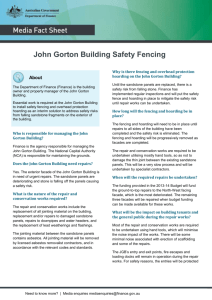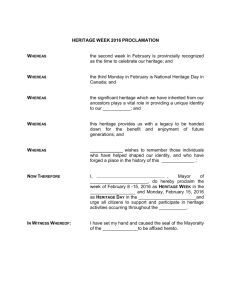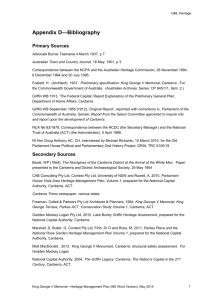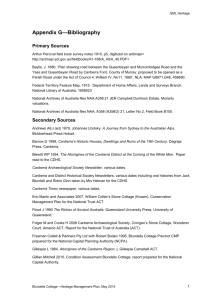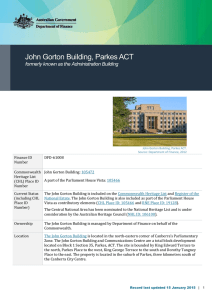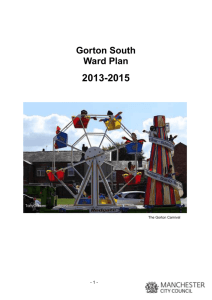Heritage Register - John Gorton Building, Parkes, ACT (formerly
advertisement
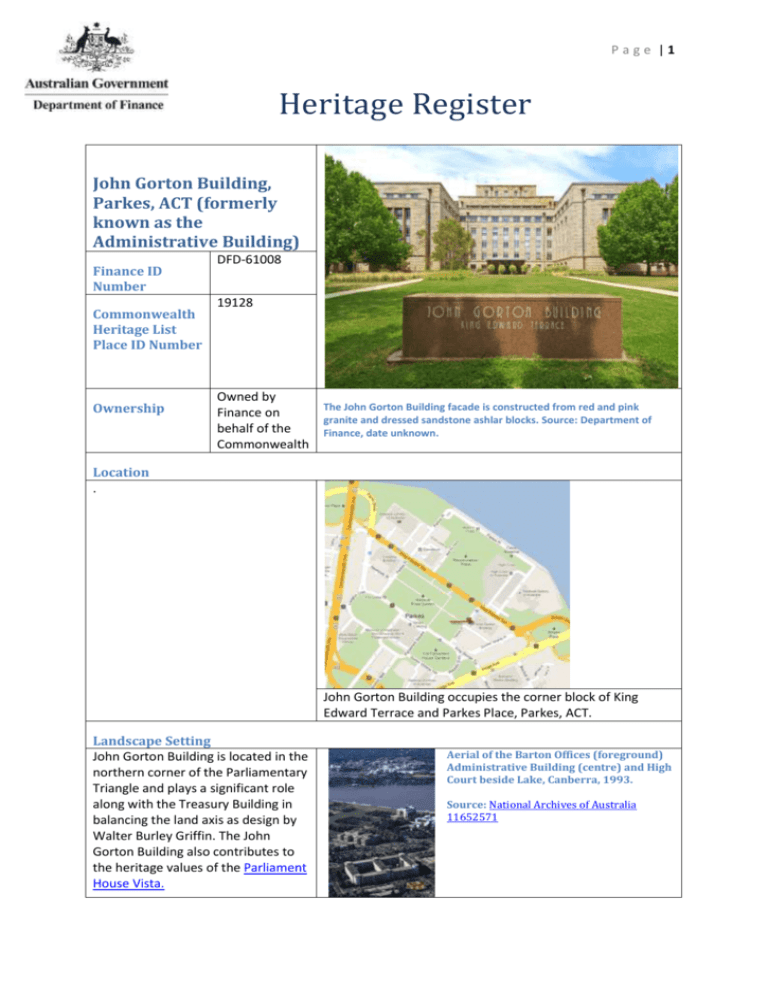
Page |1 Heritage Register John Gorton Building, Parkes, ACT (formerly known as the Administrative Building) Finance ID Number Commonwealth Heritage List Place ID Number Ownership DFD-61008 19128 Owned by Finance on behalf of the Commonwealth The John Gorton Building facade is constructed from red and pink granite and dressed sandstone ashlar blocks. Source: Department of Finance, date unknown. Location . John Gorton Building occupies the corner block of King Edward Terrace and Parkes Place, Parkes, ACT. Landscape Setting John Gorton Building is located in the northern corner of the Parliamentary Triangle and plays a significant role along with the Treasury Building in balancing the land axis as design by Walter Burley Griffin. The John Gorton Building also contributes to the heritage values of the Parliament House Vista. Aerial of the Barton Offices (foreground) Administrative Building (centre) and High Court beside Lake, Canberra, 1993. Source: National Archives of Australia 11652571 Page |2 Description of the Place John Gorton Building is a Commonwealth Administrative Building located at King Edward Terrace, Canberra ACT. The property is located in the suburb of Parkes, three kilometres south of the Canberra City Centre. Parkes is a suburb of Canberra, featuring residential and commercial development. John Gorton Building lies within the Parliamentary Triangle, Canberra’s ceremonial precinct featuring some of Australia’s most culturally significant buildings. These buildings include Parliament House, Old Parliament House, Defence Headquarters, Treasury Building, National Library and High Court of Australia. John Gorton Building comprises a ground floor, six upper floors, a basement and a sub-basement. The building was designed with the intention of influencing the design of other structures in the Parliamentary Triangle. It was designed for and has only ever been used as a Commonwealth Administration Building. Physical Characteristics The building is considered to be an example of the inter-war Stripped Classical style and was designed to match the aesthetics of existing buildings in the Parliamentary precinct. The exterior has been left largely untouched since the building’s construction. The interior has been refurbished several times although original finishes have been retained in all public areas. John Gorton building comprises a large central rectangular block with eight wings. It consists of a ground floor, six upper floors, basement, sub-basement and a communications centre (see separate Heritage Register entry). Construction of the building is of reinforced concrete beam and slab, with the façade made up of polished red granite and sandstone blocks. The façade is largely simplistic, though the western entrance comprises an exterior stone staircase and a colonnaded entrance. The building takes up the majority of the block of land, and is complemented by the manicured gardens and water fountains leading up to the eastern entrance. The Kind Edward Terrace entrance to the John Gorton Building. Source: Finance date unknown. John Gorton Building along with the Treasury Building balances the land axis. Source: Finance date unknown. John Gorton Building is an example of the inter-war stripped classical style. Source: Australian Heritage Photographic Library Barcode number: rt60288 History and Summary of Uses of the Place John Gorton building was the first building to be constructed in the Parliamentary triangle. The design was to influence other buildings in the area and for this reason was considered a key project Page |3 at the time. In the 1920s many Government Departments moved their operations from Melbourne, which was at the time the seat of the Commonwealth Government. In 1924, architect G Jones won a competition to design the building, which was to house eight Federal departments. Although work begun in 1927, work stopped and was further delayed in 1928 due to the Depression and later World War Two. Construction recommenced in 1947 although Commonwealth architects redesigned the building to accommodate a larger design. Since 1956, John Gorton building has housed a number of Government Departments and is managed by the Commonwealth. John Gorton Building under construction, 1953. Source: John Gorton Building under Construction, 1953. Source: John Gorton Building showing the concrete form, 1953. Source: ACT Heritage Library Image Number009510 ACT Heritage Library image number 001522 ACT Heritage Library Image Number 009509 Statutory Heritage Values Commonwealth Heritage List John Gorton Building formerly known as the Administrative Building, has continually provided office accommodation for key Government departments since completed in 1955. Source: National Library of Australia, 1990 nla.pic-vn3749000 Criterion D Characteristic John Gorton Building is a Commonwealth Heritage place and is protected under the Environment Protection and Biodiversity Conservation Act 1999. Statement of significance Planned in 1924, designed in 1946 and completed in 1956, the Administrative Building is significant as a good Canberra example of the inter-war Stripped Classical style. Key features of this style displayed by the building include: the symmetrical facades; the division of the elevations into vertical bays; the occasional use of correct Classical details; the use of a basic Classical column form; the expressed portico; the simple surface treatments; and subdued spandrels between the storeys which emphasise verticality. Design elements which retain a high level of integrity include the exterior, foyers, lift lobbies and central corridors. The Administrative Building is also part of the significant cultural landscape of the Parliamentary triangle. It occupies a prominent and strategic location flanking the land axis in accordance with the 1916 Griffin plan. Together with the later Treasury Building balancing its mass across the central lawns of the land axis, the Administrative Building contributes to the planned aesthetic qualities of the Parliamentary triangle Gazetted Commonwealth Heritage values Planned in 1924, designed in 1946 and completed in 1956, the Administrative Building is significant as a good Canberra Page |4 Drawing; Perspective view of proposed Government Printing Office and Department,( Administrative Building), Canberra, 1929. Source: National Archives of Australia 3152411 Criterion E Aesthetic example of the inter-war Stripped Classical style. Key features of this style displayed by the building include: the symmetrical facades; the division of the elevations into vertical bays; the occasional use of correct Classical details; the use of a basic Classical column form; the expressed portico; the simple surface treatments; and subdued spandrels between the storeys which emphasise verticality. Design elements which retain a high level of integrity include the exterior, foyers, lift lobbies and central corridors. Gazetted Commonwealth Heritage values The Administrative Building is also part of the significant cultural landscape of the Parliamentary triangle. It occupies a prominent and strategic location flanking the land axis in accordance with the 1916 Griffin plan. Together with the later Treasury Building balancing its mass across the central lawns of the land axis, the Administrative Building contributes to the planned aesthetic qualities of the Parliamentary triangle. Canberra - The central administrative area of Parkes in Canberra, the National Capital of Australia - In the background is the Administrative Block, the largest building in Canberra housing Government departments, 1961. Source: National Archives of Australia Barcode: 11250261 Non-Statutory Heritage Listings National Trust Register of Significant Places Register of the National Estate ACT Register of Significant Twentieth Century Architecture Register ACT Heritage Register John Gorton Building is an Interim Place on the National Trust Register of Significant Places. John Gorton Building was included in the Register of the National Estate in 1987. In February 2012, the RNE became a non-statutory archive. John Gorton Building has been identified as an example significant Twentieth Century architecture in the ACT. John Gorton Building was nominated for inclusion on the ACT Heritage Register. However, as the John Gorton Building is located on Commonwealth and already listed on the CHL, the ACT Heritage Council decided not to include the John Gorton Building on the ACT Heritage Register (April 2013) as it would provide no additional protection to the heritage values of the place. . Page |5 Property or Information Access Restrictions or Requirements if any Conservation Documents or References John Gorton Building is a secure government office building. The building is not open to the public. Garnett, Rodney and Hyndes, Danielle, The Heritage of the Australian Capital Territory, National Trust of Australia (et al), Canberra, 1992. Philip, Cox, Richardson, Taylor and Partners, Pty Ltd, Administrative Building, Conservation Plan for Australian Estate Management, Canberra, 1992. Record Last Updated 30 October 2013


